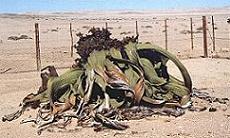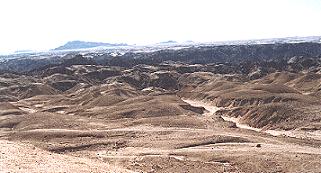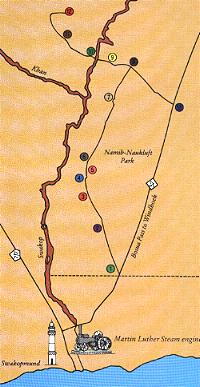Welwitschia Mirabilis
The first Welwitschia plant was
discovered by Austrian botanist
Friedrich Welwitsch (1806-1872)* in
1860 in the Namib desert in the southern part of Angola. The plant was named after
Friedrich in recognition of his successful botanical research and because he found and
collected it first.
This Welwitschia is a plant of remarkably bizarre habits and survives in very harsh
localities where the annual rainfall is often less that 25 mm and where the coastal fog is
equivalent to about further 50 mm. The Welwitschia's oldest living specimens are estimated
at 1500 to 2000 years is capable of surviving severe conditions of stress. Most of the
observations are done on the Welwitschia Fläche, a desert plain, about 50 km east of
Swakopmund and east of the confluence of the Khan and Swakop rivers.
The Welwitschia is considered to be a gymnosperm, although the
relationship with other species in this class is not clear. The position of the
Welwitschia in the hierarchy of the plant remains tenuous.
The Welwitschia is endemic to the Namib desert, i.e. found only in the area. The Namib
desert is one of the world oldest deserts with extreme arid conditions stretches in the
western part of Namibia along the coast up to the south-western part of Angola. The
Welwitschia is restricted to a narrow path of this desert. The plant resembles a woody
carrot. The stem is exceedingly fibrous and has a prominent, thick, corrugated periderm.
Unequal growth causes the stems of these plants to become weirdly distorted and there are
only two strap-shaped leaves, growing from a terminal groove in the photosynthetic tissue
of the stem. One of the most magnificent specimen is found in the Welwitschia Fläche. One
of the large plants measure 1.5 m from the soil surface to the highest part of the stem.
The Pforte Welwitschia is 1.2 m tall and the circumference at the base of its leafs is 8.7
m. The roots of Welwitschia can grow up to 30 meters deep, sponge and lateral roots are
also a part of the root system.
Leaf characteristics. The leafs are the longest-lived in the plant kingdom, they are
evergreen, a single pair and generally broad and flat. The broadest unbroken leaf is found
in the Fläche measures 179 sm. This particular leaf was 6 meters long of which 3.15
meters were living tissue. The surface that this leaf covers helps the plant to survive at
a temperature on the soil as high as 65 'C. It keeps the soil under the plant cool and
moist. The leafs grow annually an average 13.8 sm. Therefore the plant can produce up to
150 m of leaf tissue over a growth period of 1000 years. The leaves are on average 1.4 mm
thick. The leaves that lay on the sand surface also prevent wind erosion. Even under gale
force conditions the broad leaves remain rigid and immobile. Absorbtion of water through
the stomata must be regarded as very interesting, this characteristics of the leaves has
ensured the species survival. The stomata remains open until the fog has lifted and
although much of the water that has condensed on the leaves runs off the direct intake of
a proportion of this water takes place.
Unlike other plants the stomata is open under foggy conditions
and closes when it is hotter. This ensures that no water is evaporated during the heat of
the day.
Reproductive anomalies. The female plant has large cones while the male plant has flowers.
The male reproductive structure has six stamens each with a anther and a pistil. A female
plant of average size may bear from 60 to 100 or even more cones. The Welwitschia female
plant can produce a lot of seeds: up to 10 000 or even more. Unlike other known plants
fertilisation occur in the pollen tube rather than in the embryo sac. I is known that wind
plays a major role in the fertilisation, but much has to be learned about a little insect
(Probergrothiussexpunctalis) which also helps with the fertilisation.
Seed and seedling. The seed units consists of a seed and a paper husk of winged segments.
It is suggested that very strong wind would be required to successfully distribute the
seeds. Most of the seeds that are shed have a very little chance of germinating. Assuming
that 50% of the seeds are fertile and 80% of that seeds are infected with a fungus
(Aspergillus niger). However, it is doubted that one-hundredth of 1% of all seeds produced
germinate and develop into a mature plant. Seeds that are moisturized excessively do not
germinate but develop an extremely unpleasant odour.
Water absorption. Most plants absorb water from the soil through their roots. This water
is then transported to the stem and the roots and the water is then lost through the
stomata evaporation. The Welwitschia plant works the other way around. It is able to
absorb water from fog through millions of stomata on the surface of it's large leaves.
From there the water moves to the rest of the plant.
Conclusion. Serious doubts have been expressed as to whether this wonderful plant,
Welwitschia, is not perhaps facing an extinction. Considered against this plant longevity
and remarked adaptation to it's environment, there should be no reason for concern. It is
proper thought that this plant be awarded the National protection it deserves and in this
respect it is extremely gratifying to know that the Welwitschia Fläche where the oldest
and largest plant occur has now been incorporated into the Namib Naukluft park.
*Dr. Friedrich Welwitsch (1806-1872)
Friedrich Welwitsch was born in Austria where he worked for some time as a
theatre critic. Later he fled to Portugal where he started to work as a plant collector.
Several years later he was sent to Angola by the Portuguese government where he made over
5000 collections during 12 years in the country. Some were completely new to science at
that time and contained large amount of useful information.
When he returned from Angola Welwitsch decided to settle in London to stay close to the
Natural History Museum and the Royal Botanical Gardens. He worked there until his death in
1872.
After his death the Portuguese Government (who funded his collections) took the executors
of his estate to court to try to retrieve the collections. After a long court battle which
lasted 3 years a compromise was reached - the Portuguese Government got the first set of
duplicates and the Natural History Museum received the second set.
Dr. Friedrich Welwitsch is buried in Kensal Green Cemetery in London. His his
tombstone is decorated with an engraving of Welwitschia. Learn about other rare
plants and flowers.
The Welwitschia Plains drive
- Namib Naukluft Park
The Namib desert is a unique in
its overwhelming beauty. The Welwitschia drive, which falls within the Namib
Naukluft Park, offers the exciting opportunity of discovering various features
of this fascinating desert plain. The round trip by car takes
approximately four hours, allowing one to get out at each of the numbered
beacons to explore the area. The required permit, which allows entrance to the
park as a whole, is obtainable from the Namibia Wildlife Resorts office in
Swakopmund. If you decide to stay over in the park, there are many camping sites
to choose from, including one at the Welwitschia trail. A camping permit can
also be obtained from the office.
How to get there: From Swakopmund follow the tarred road to Windhoek and
then turn off onto the Khomas Hochland road (signposted) just beyond the Martin
Luther steam engine. Continue along this road, crossing the Swakop River,
until you reach the entrance to the Namib Naukluft Park. After a short distance
you will see the signpost at the start of the trail. Turn left here. After a
short while you will come across the first of the 13 numbered stone beacons that
indicate places of particular interest.
1. At a first glance it would seem that the Namib desert is a dry and barren
region, but look again. The ground and stones are covered with a great variety
of lichens. They depend for their survival on the mist
that moves in from the sea over the desert at night and in the morning. Take
note of the lichens that look like black fragments of dead plant material. They
lie loose on the surface and tend to collect in furrows. If placed in water they
unfold and change colour.
2. Along the way two kinds of drought resistant shrubs are predominant: The
Dollar bush, name given because of its coin-like round leaves, and the Ink
bush, with its fine leaves and spindly appearance. Both these kinds of plants
are well adapted to an area which receives an average of less than 20 mm of rain
a year, and then mostly in single downpours. Often there is no rain in the area
at all for several years.
3. Here the tracks of an oxwagon trail, used decades ago, can still be seen
where it leaves the present road. The route was called the "Baaiweg"
as supplies were transported from the coast to the inland. These tracks are
still visible today because the lichens that were destroyed by the routes are
not yet fully reestablished. Lichens grow extremely slowly, less than 1 mm a
year. It is therefore most important for the ecology in the area that travellers
should keep to existing roads at all times.
4. The valleys of the Swakop river form a spectacular ''moon landscape''. It
came into existence as the river cut through the softer surface deposits. These
soft materials were laid down some 460 million years ago when the area's climate
was more wet. In the background one can see the Rossing mountain.
5. Because of the Namib's exceptional climate with its misty nights, the lichen
fields here are more extensive than anywhere else in the world. Again one can
see how many different kinds of lichens grow here. One may easily mistake a
certain lichen for soil, as it has the identical colour. Other lichens, such as
those with orange or gray-green "tufts", are much more easy to
recognize. An important function of lichens is to fix and stabilize the soil.
6. From here one has another splendid view of the Swakop Valley landscape. In
the foreground are furrows caused by erosion.
7. It comes as a surprise to find remnants of a human sojourn in this desolate
landscape. On this spot South African troops made camp for a few days in 1915
during the First World War. Along with the broken bottles and rusted cans, one
can also see the tracks of an early form of tracked vehicle. Please do not
remove anything.
8. To explore the next few beacons on the trail, one must turn left at the
T-junction. On the right there is a clear example of a black ridge of dolerite
that snakes across the hills. Dolerite is a hard rock which weathers more slowly
than the surrounding rock. This results in a thin band of black dolerite along
the hill tops.
9. The route now takes one through a dolerite dyke. This is an example of
igneous rocks, where molten lava penetrated into a crack in the older gray
granite rock and now forms the backbone of the ridge.
10. Compared with the desert plains the Swakop River valley has lush vegetation.
The camelthorn, the anaboom and the tamarisk all grow here, and tap the river
that flows deep underground. Picnic and camping sites are provided so that one
can relax here in the shade. Note the parasite plants that grow on many of the
trees. Their sticky seeds are spread by the great variety of birds which
frequent the valley.
11. The Welwitschia mirabilis is unique to the Namib. It is in fact a coniferous
dwarf tree that is related to the pine tree.
13. The last beacon on the trail is that of the abandoned Von Stryk mine. This
small, hand excavated iron ore mine was worked during the 1950's, but it was not
economically viable in the long run. The mine is still privately owned. The
entire Namib Naukluft Park carries relics of prospectors and miners who operated
here - mostly before 1965.
@
The Welwitschia Plains - scenic drive: brochure
Facebook:
NAMIBIA:
https://www.facebook.com/groups/namibia.namibia
SESRIEM SOSSUSVLEI:
https://www.facebook.com/groups/sossusvlei
NAMIB-NAUKLUFT NATIONAL PARK:
https://www.facebook.com/groups/namib.naukluft
TRAVEL NAMIBIA:
https://www.facebook.com/groups/travelnamibia
Related:
Accommodation
in the area:
Activities in the area:
Contact & information:
E-mail: info@namibweb.com



Page created and serviced by

www.namibweb.com
Copyright © 1998-2025
namibweb.com - The online guide
to Namibia
All rights reserved |
JOIN
|
VIDEO PORTFOLIO
|
VIDEO/PHOTO COLLECTION
Telegram
| YouTube |
Blog
Page is sponsored by ETS &
Exploring Namibia TV
Disclaimer: no matter how often this page is updated and its accuracy is checked,
www.namibweb.com and ETS
will not be held
responsible for any change in opinion, information, facilities, services,
conditions, etc. offered by
establishment/operator/service/information provider or any third party
